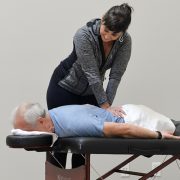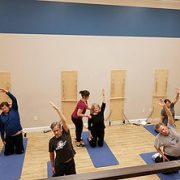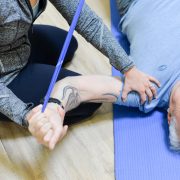Movement Strategies to Combat the Stress of Pandemics and Politics
I think we can all agree that 2020 has been far from a typical year. We continue to find ourselves in a state of uncertainty — and it’s causing people to live in a constant state of stress.
Eight months ago, when this pandemic began, we saw a huge surge in back and neck pain coming into the office. At first, I knew it was due to people being stuck at home and off their routines. But now, and especially with the current political climate, I’m seeing a different and more prevalent kind of stress-induced pain in my office. It’s caused by the body’s natural “fight or flight” response and it’s taking a real physical toll. People feel it in their necks, backs, hips, and shoulders and are looking for help to get rid of it.
Why does this happen?
Fight or Flight is a natural (and important) stress response to anything your brain perceives as stressful or frightening. Back in the caveman days, this was essential to our survival. If you saw a lion, for example, and he looked hungry, you needed to be able to quickly get yourself out of danger. Fight or flight is your body’s way of doing just that. Your heart and respiratory rate increase, so that more blood and oxygen can be pumped toward your brain and muscles – where you need it most – so that you can quickly run and flee away from danger. Another consequence of fight or flight is tense, tight muscles. Your body does this to protect you from the threat. Our ancestors would only find themselves in this situation once in a while. The rest of the time, their bodies functioned normally and without this stressful response.
Fast forward to our modern day lifestyles… our brains perceive threats and stressors differently.
Everything from a big presentation due at work to a difficult conversation with your boss, spouse, or kid’s teacher, to bad news flooding our newsfeeds and email every second of the day can activate this response. Add a pandemic and election cycle on top of all that, and we find ourselves living in a chronic state of fight or flight. And we are evolutionarily conditioned to look for ways to escape these situations to get “out of danger.”
Even though fight or flight is natural and embedded deeply into our brains, it was meant to be life-saving and reserved for very specific situations – not all day every day. If your body never comes out of this, your muscles become chronically tight, resulting in constant pain and tension. Stretching and massage might help to temporarily relieve these symptoms, but they will come right back if you don’t learn to manage your fight or flight response for what it is.
How do you manage and interrupt your fight or flight response?
One easy way is to breathe. This is one of the most practical ways to calm your nervous system by lowering your heart and respiratory rate. You can literally do this in 30 seconds starting the moment you feel any kind of tension or tightness in your body. The better you become at recognizing tension in your body ahead of time, the easier it will be to interrupt and stop your fight or flight response. Simple, deep breathing is a signal to your nervous system that you are safe – and that you don’t need to prepare to run or flee by tightening up all of your muscles.
Daily exercise is another easy way to combat stress.
When you’re in fight or flight, your body is preparing to either engage the threat or run from it. If you don’t do either of these things, your nervous system doesn’t know that you’re out of “danger.” Intentional movement and exercise solves this problem and helps to close the loop of your flight or flight response. With regular movement and exercise, you can help better regulate this response since it is so constant in our lives right now. Our exercise of choice is Pilates. It’s a particularly effective exercise system to combat fight or flight because it involves focused and controlled breathing and it works your whole entire body. And since we work with so many folks suffering from neck and back pain, we also love it because Pilates targets your core. Good core strength is one of the BEST ways to keep neck and back pain away.










